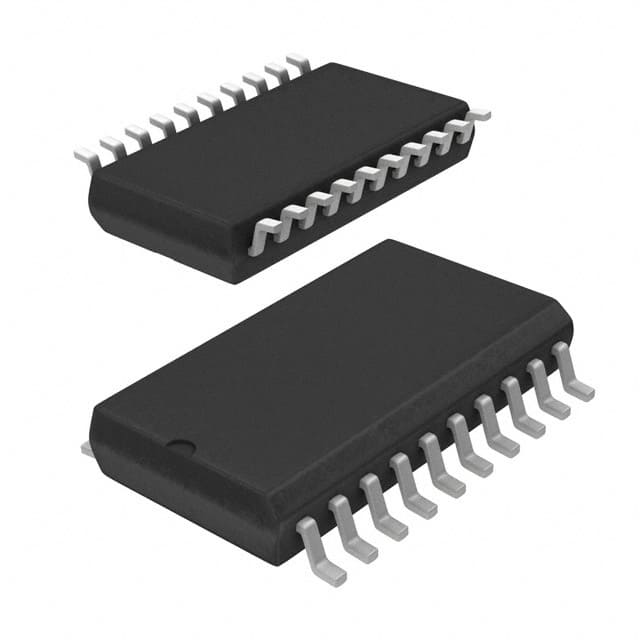Consulte las especificaciones para obtener detalles del producto.

CD74HCT244M
Product Overview
- Category: Integrated Circuit (IC)
- Use: Buffer/Line Driver
- Characteristics: High-Speed, CMOS Logic, Octal Bus Buffer
- Package: SOIC (Small Outline Integrated Circuit)
- Essence: The CD74HCT244M is an octal bus buffer that provides high-speed, non-inverting buffering for a wide range of digital applications.
- Packaging/Quantity: The CD74HCT244M is typically available in reels or tubes, with a quantity of 250 or 2000 units per reel/tube.
Specifications
- Supply Voltage: 2V to 6V
- Logic Family: HCT (High-Speed CMOS)
- Number of Buffers: 8
- Input/Output Compatibility: TTL, CMOS
- Propagation Delay: 9 ns (typical)
- Operating Temperature Range: -40°C to +85°C
- Package Type: SOIC-20
Pin Configuration
The CD74HCT244M has a total of 20 pins, which are assigned as follows:
- GND (Ground)
- A1 (Input/Output)
- B1 (Input/Output)
- Y1 (Output)
- A2 (Input/Output)
- B2 (Input/Output)
- Y2 (Output)
- A3 (Input/Output)
- B3 (Input/Output)
- Y3 (Output)
- A4 (Input/Output)
- B4 (Input/Output)
- Y4 (Output)
- VCC (Positive Power Supply)
- OE (Output Enable)
- Y5 (Output)
- A5 (Input/Output)
- B5 (Input/Output)
- Y6 (Output)
- GND (Ground)
Functional Features
- The CD74HCT244M provides non-inverting buffering for digital signals.
- It operates at high-speed, making it suitable for time-critical applications.
- The octal bus buffer design allows for easy interfacing between different logic families.
- The output enable (OE) pin allows for tri-state operation, enabling multiple devices to share a common bus.
Advantages and Disadvantages
Advantages: - High-speed operation - Wide supply voltage range - Compatibility with TTL and CMOS logic levels - Tri-state output capability
Disadvantages: - Limited number of buffers (8 in total) - Not suitable for applications requiring higher current drive capabilities
Working Principles
The CD74HCT244M operates based on the principles of CMOS logic. It uses a combination of MOSFET transistors to achieve high-speed, low-power buffering of digital signals. The input signals are amplified and inverted by the internal circuitry, providing a non-inverted output signal.
Detailed Application Field Plans
The CD74HCT244M is commonly used in various digital applications, including:
- Microprocessor/Controller Interfacing: It facilitates communication between microprocessors/controllers and peripheral devices by buffering the data/address lines.
- Memory Systems: It can be used to interface memory modules with the memory controller, ensuring reliable data transfer.
- Communication Systems: It enables signal buffering and level shifting in communication interfaces such as UART, SPI, and I2C.
- Industrial Automation: It plays a crucial role in connecting sensors, actuators, and control systems, ensuring proper signal transmission.
Detailed and Complete Alternative Models
- SN74HCT244: Similar octal bus buffer IC from Texas Instruments.
- MC74HCT244: Octal bus buffer IC from ON Semiconductor.
- 74HCT244: Generic octal bus buffer IC available from various manufacturers.
These alternative models offer similar functionality and can be used as replacements for the CD74HCT244M in most applications.
Word count: 430 words
Enumere 10 preguntas y respuestas comunes relacionadas con la aplicación de CD74HCT244M en soluciones técnicas
Sure! Here are 10 common questions and answers related to the application of CD74HCT244M in technical solutions:
Q: What is CD74HCT244M? A: CD74HCT244M is a high-speed CMOS octal buffer/line driver with 3-state outputs. It is commonly used for signal buffering and level shifting applications.
Q: What is the operating voltage range of CD74HCT244M? A: CD74HCT244M operates within a voltage range of 4.5V to 5.5V.
Q: What is the maximum output current of CD74HCT244M? A: The maximum output current of CD74HCT244M is typically around 6mA.
Q: Can CD74HCT244M be used for bidirectional communication? A: No, CD74HCT244M is a unidirectional buffer and cannot be used for bidirectional communication. For bidirectional communication, you would need a different type of IC like a transceiver.
Q: What is the purpose of the 3-state outputs in CD74HCT244M? A: The 3-state outputs allow the device to be effectively disconnected from the bus, enabling multiple devices to share the same bus without interfering with each other.
Q: What is the maximum frequency at which CD74HCT244M can operate? A: CD74HCT244M can operate at frequencies up to 25 MHz.
Q: Can CD74HCT244M drive capacitive loads directly? A: Yes, CD74HCT244M can drive small capacitive loads directly. However, for larger capacitive loads, it is recommended to use an external series resistor to limit the current.
Q: Is CD74HCT244M tolerant to electrostatic discharge (ESD)? A: Yes, CD74HCT244M has built-in ESD protection, making it more robust against ESD events.
Q: Can CD74HCT244M be used in automotive applications? A: Yes, CD74HCT244M is suitable for automotive applications as it meets the necessary standards and specifications for automotive electronics.
Q: Are there any specific layout considerations for using CD74HCT244M? A: Yes, it is important to follow proper PCB layout guidelines, such as minimizing trace lengths, providing adequate decoupling capacitors, and ensuring proper grounding, to optimize the performance of CD74HCT244M.
I hope these questions and answers help! Let me know if you have any further queries.

